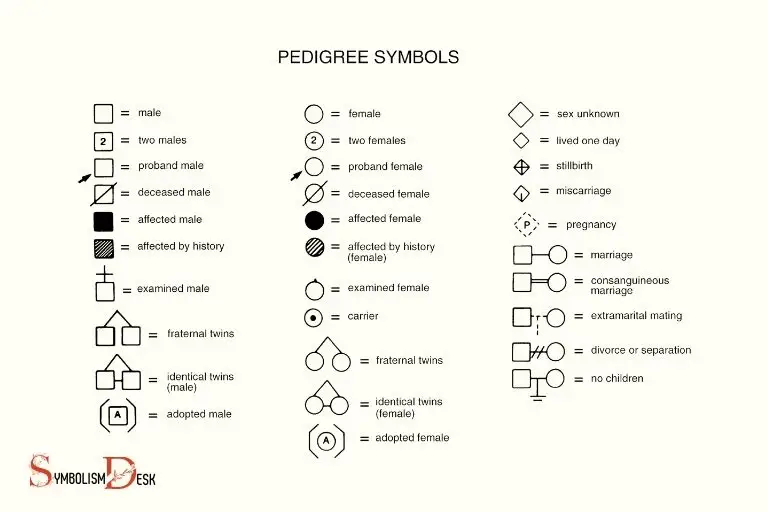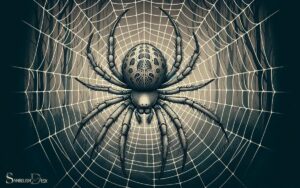What Do the Pedigree Symbols Mean? Genetic Traits!
Pedigree symbols represent the genetic traits and relationships within a family. Squares symbolize males, circles represent females, and diamonds are used when the gender is unknown or not relevant.
An individual affected by the trait being studied is marked with a filled symbol. Horizontal lines joining two symbols refer to mating, whereas vertical lines dropping from one symbol depict their offspring.
Pedigree symbols are the methodology used in genetics to understand and illustrate genealogical relationships and the inheritance of genetic traits.
The use of a uniform set of symbols allows for clear and standardized pedigrees, simplifying research and communication in genetics.
Pedigree symbols form the basis of genetic mapping and studying inheritance patterns in families.
They help geneticists and medical professionals understand the probability of an individual inheriting a particular trait or disease. By interpreting these symbols correctly, we gain insight into complex genetic relationships and patterns.
10 Pedigree Symbols and Their Meanings
| Pedigree Symbol | Description |
|---|---|
| Square | Male |
| Circle | Female |
| Diamond | Sex Unknown/Unspecified |
| Filled Symbol | Individual is affected by the trait |
| Empty Symbol | Individual is not affected by the trait |
| Half-Filled Symbol | Individual is a carrier of the trait |
| Dot Inside Symbol | Individual is a carrier of the trait (Alternate) |
| Line Through Symbol | Deceased Individual |
| Roman Numerals on Left Side | Generation Number |
| Arabic Numerals Under Symbol | Individual Number within Generation |
Key Takeaway

Five Facts About: Pedigree Symbols and Their Significance
What Are Pedigree Symbols?
Definition Of Pedigree Symbols
When we talk about pedigrees, we’re referring to a way of illustrating familial relationships. In animal breeding or humans, a pedigree can present an individual’s lineage, genetic features and possible genetic disorders.
Pedigree symbols, however, refer to the graphical illustrations that represent individuals and their connections on a pedigree chart.
These symbols help one understand familial relationships and inheritance patterns and calculate genetic risks.
Some standard symbols that are prevalent in pedigree charts are:
- Square: Representing males
- Circle: Representing females
- Vertical straight line in between square and circle: Signifying marriage
- Horizontal straight line – signifying offspring
Brief History And Evolution
The use of pedigree charts and symbols has been here since the 1800s, with agricultural breeders applying these charts for livestock breeding.
In the early 1900s, human geneticists started using pedigree charts to understand familial patterns of inherited traits and genetic disorders.
From rudimentary symbols, the pedigree symbols have evolved over time into the standard version that we use today.
Some fascinating historical facts related to pedigree symbols are:
- The first american textbook to incorporate pedigree charts in genetics was ‘heredity and eugenics’ by charles davenport.
- The popular symbols for genders, squares and circles, were not necessarily like that in the early days. For example, some medieval medieval genealogy used symbols like triangles or even crescents to represent individuals’ gender.
- Standard symbols that we use today were established in 1968 by the national society of genetic counselors.
Pedigree symbols on the charts are essential to understand genetic inheritance better, and they continue to evolve with time.
How To Read Pedigree Symbols
Types Of Pedigree Symbols
Understanding the various pedigree symbols used in a pedigree chart is essential to analyze a family’s genetics.
Here are the different pedigree symbols and what they represent:
- Square: A square is used to represent a male individual in the family tree.
- Circle: A circle is used to represent a female individual in the family tree.
- Shaded symbol: A shaded or filled square or circle represents an individual who has a genetic trait, disease, or disorder.
- Half-shaded symbol: A half-shaded or half-filled square or circle indicates that an individual is a carrier of a genetic trait, disease, or disorder.
- Horizontal line: A horizontal line connects a male and a female individual to denote marriage.
- Vertical line: A vertical line is used to link parents and their offspring.
Pedigree Chart Layout
A pedigree chart is a diagram that displays the biological relationships of individuals in a family tree.
The layout of a pedigree chart is as follows:
- Each generation is represented by a row, with the youngest generation at the bottom of the chart.
- Parents are shown as connected by a horizontal line.
- Offspring are placed below their parents and are connected to them by vertical lines.
- Males are depicted by squares, while females are depicted by circles.
- A line between parents with a vertical line below represents children born from that union.
Clearing Confusions: Common Misinterpretations
Interpreting a pedigree chart can be tricky, and some common misinterpretations include:
- Assuming that a genetic disorder must be present in every generation.
- Believing that carrier parents will always have affected offspring.
- Assuming that children who are carriers will always have children who are carriers.
- Believing that an individual without a known family history of a genetic disorder cannot be a carrier.
- Assuming that an individual with a genetic disorder will not live long enough to reproduce.
By understanding the basics of pedigree symbols and the layout of a pedigree chart, you can easily analyze and interpret the inheritance patterns of genetic traits, disorders, and diseases within a family.
Common Pedigree Symbols And Their Meanings
Pedigree symbols can be a little intimidating for anyone who is not yet familiar with their meaning. But once you have a basic understanding of the most commonly used pedigree symbols, reading a pedigree chart will be a piece of cake!
Circle
- A circle within a pedigree represents females. The individual’s name is usually listed inside the circle, along with other important details such as the birth date and, if relevant, the date of death.
- If the circle is shaded, it indicates that the female has been diagnosed with a genetic disorder or another condition worth noting.
Square
- The square represents males in a pedigree. Similar to a circle, the name and essential information such as birth and death dates are often listed within the square.
- If the square is shaded, it signifies that the male has been diagnosed with a condition or disease worth noting.
Triangle
- In pedigrees, triangle shapes are usually used to represent pregnancies or children who have not yet had their gender assigned.
- The point of the triangle is usually aligned with the base of another shape (circle or square) representing the couple that had the child, with the flat side of the base facing outward, while the point faces towards the couple’s offspring.
Diamond
- A diamond-shaped symbol is generally used to represent a fetus during pregnancy, as opposed to a living person.
- The point of the diamond typically points towards the progenitors of the pregnancy, and the name and other information about the fetus are often provided inside the diamond.
Other Shapes
Occasionally, different shapes are used in pedigrees, particularly if a specific family feature or event, such as adoption, needs to be expressed.
A triangle or square with a notch removed from one side represents a miscarriage, stillbirth, or an individual that has died. Squares or circles with a diagonal line drawn through them represent someone deceased.
Shading-Fill And Half-Shading
- Shading in pedigree charts is used to call attention to an individual who has a genetic or medical condition, as already explained.
- Biblically, half shading can be used for persons who are carriers of a genetic trait but are themselves unaffected by it.
Special Characters And Annotations
- The use of special characters and annotations is standard in pedigree charts.
- Symbols such as “x”, “=”, “+’’, and “: Ii’, among others, are often used to represent specific genetic features. These legends can vary between individuals and groups, so it’s essential to double-check these legends to make sure that they are used consistently.
As with anything new, it may take some time to understand the pedigree symbols fully. However, once you become familiar with the most commonly used symbols, you will find reading pedigree charts a breeze!
Interpreting Pedigree Symbols: Examples And Demonstrations
Pedigree symbols are a vital tool in genetic counseling and medical research. However, the subject can be challenging to understand due to the abundance of symbols involved. Many of these symbols have specific meanings, such as the greek symbol delta meaning a carrier of a genetic trait. It is important for genetic counselors and researchers to have a solid understanding of these symbols in order to effectively communicate and interpret genetic information. With proper education and training, professionals can navigate the complexities of pedigrees and provide accurate guidance to patients and families.
This post will cover the interpretation of pedigree symbols with examples and demonstrations that make it easy to understand.
Case Studies
Here we will discuss some case studies involving pedigree symbols.
Two normal parents with an affected offspring: This scenario is known as an autosomal dominant inheritance pattern.
The offspring has inherited the dominant abnormal gene from one parent. Each of the parents can pass on either the dominant or the normal gene to their offspring.
Two normal parents with an unaffected offspring: This inheritance pattern is known as autosomal recessive. Each parent is carrying a recessive gene, but since both parents are normal, their offspring doesn’t inherit the abnormal genes.
One parent affected, one normal and the offspring is affected: This pattern is typical of dominant inheritance, with the affected parent passing the dominant abnormal gene to the offspring.
Real-Life Examples Of Pedigree Charts In Genetic Counseling
Pedigree charts are commonly employed in genetic counseling sessions to identify genetic patterns present in a family.
Here are some examples:
- A genetic counselor may use a pedigree chart to identify the risk of inheriting a genetic disorder in an individual with a family history of a particular disease.
- Pedigree charts may also help establish inheritance patterns in families where a genetic disorder affecting more than one person is present.
- Genetic counselors may also use pedigree charts to determine whether a genetic test is necessary for an individual with a family history of a genetic condition.
Pedigree Symbols Use Cases In Medical Research
Pedigree charts have wide-ranging use cases in medical research.
Some of their applications include:
- Geneticists often use pedigree charts to gain insights into disease inheritance and better understand the genetics of human disease.
- Researchers use pedigree charts to identify inheritance patterns and map disease genes in families.
- Studying the inheritance patterns of certain diseases may help researchers develop new treatments and therapies.
Interpreting pedigree symbols requires a clear understanding of the various symbols used and their significance.
The examples and demonstrations included in this post illustrate how pedigree symbols are used in genetic counseling and medical research.
By using pedigree charts, healthcare professionals can better understand disease inheritance patterns, make accurate diagnoses, and develop effective treatments.
FAQ About What Do The Pedigree Symbols Mean
What Do The Squares Mean In A Pedigree Chart?
Squares in a pedigree chart represent males, and they are always colored in.
What Do The Circles Mean In A Pedigree Chart?
Circles in a pedigree chart represent females, and they are always non-colored.
What Does A Horizontal Line Mean In A Pedigree Chart?
A horizontal line between a circle and a square means they are married or in a partnership.
What Does A Vertical Line Mean In A Pedigree Chart?
A vertical line connecting parents to their children indicates a biological offspring.
What Is The Purpose Of Using Different Symbols In A Pedigree Chart?
Pedigree chart symbols help to identify relationships between family members, genetic patterns, and medical conditions.
Conclusion
Understanding the meaning behind pedigree symbols is vital for anyone who hopes to decipher the complex genealogy of a family tree.
The various shapes and lines used to represent different relationships can be confusing at first, but with a little patience, anyone can learn to read them like a seasoned genealogist.
Remember, squares represent men, circles represent women, and lines indicate the types of relationships between them.
As you delve deeper into your research, you may come across additional symbols that represent adoptions, stillborn children, and other important details.
By familiarizing yourself with all of the various pedigree symbols, you’ll be better equipped to uncover the fascinating stories and histories hidden within your family tree.
Keep exploring, keep learning, and never give up in your quest for knowledge, and you will be able to unravel the secrets of your past in no time!






